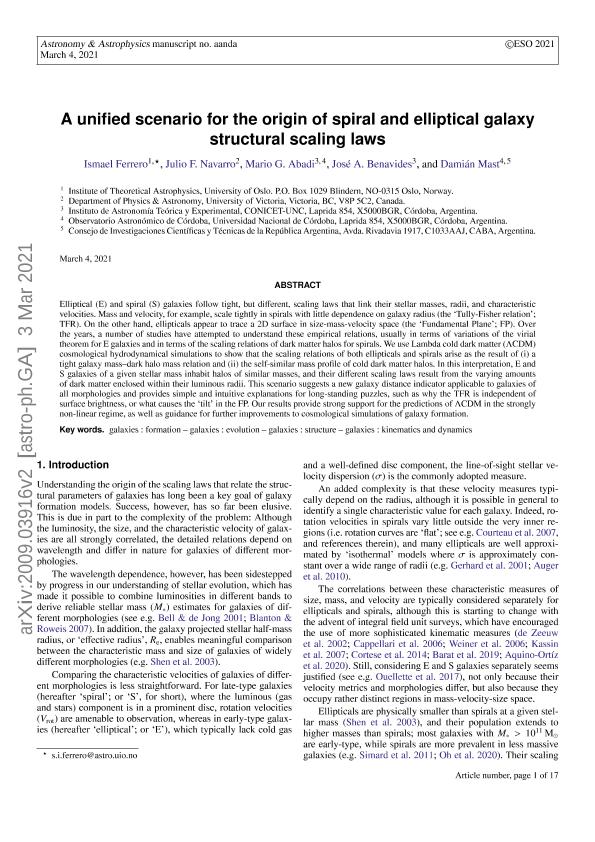Mostrar el registro sencillo del ítem
dc.contributor.author
Ferrero, Santiago Ismael

dc.contributor.author
Navarro, Julio F.
dc.contributor.author
Abadi, Mario Gabriel

dc.contributor.author
Benavides Blanco, Jose Antonio

dc.contributor.author
Mast, Damian

dc.date.available
2022-09-21T17:37:28Z
dc.date.issued
2021-04-26
dc.identifier.citation
Ferrero, Santiago Ismael; Navarro, Julio F.; Abadi, Mario Gabriel; Benavides Blanco, Jose Antonio; Mast, Damian; A unified scenario for the origin of spiral and elliptical galaxy structural scaling laws; EDP Sciences; Astronomy and Astrophysics; 648; 26-4-2021; 1-17
dc.identifier.issn
0004-6361
dc.identifier.uri
http://hdl.handle.net/11336/169788
dc.description.abstract
Elliptical (E) and spiral (S) galaxies follow tight, but different, scaling laws that link their stellar masses, radii, and characteristic velocities. Mass and velocity, for example, scale tightly in spirals with little dependence on galaxy radius (the 'Tully-Fisher relation'; TFR). On the other hand, ellipticals appear to trace a 2D surface in size-mass-velocity space (the 'Fundamental Plane'; FP). Over the years, a number of studies have attempted to understand these empirical relations, usually in terms of variations of the virial theorem for E galaxies and in terms of the scaling relations of dark matter halos for spirals. We use Lambda cold dark matter (ΛCDM) cosmological hydrodynamical simulations to show that the scaling relations of both ellipticals and spirals arise as the result of (i) a tight galaxy mass-dark halo mass relation and (ii) the self-similar mass profile of cold dark matter halos. In this interpretation, E and S galaxies of a given stellar mass inhabit halos of similar masses, and their different scaling laws result from the varying amounts of dark matter enclosed within their luminous radii. This scenario suggests a new galaxy distance indicator applicable to galaxies of all morphologies and provides simple and intuitive explanations for long-standing puzzles, such as why the TFR is independent of surface brightness, or what causes the 'tilt' in the FP. Our results provide strong support for the predictions of ΛCDM in the strongly non-linear regime, as well as guidance for further improvements to cosmological simulations of galaxy formation.
dc.format
application/pdf
dc.language.iso
eng
dc.publisher
EDP Sciences

dc.rights
info:eu-repo/semantics/openAccess
dc.rights.uri
https://creativecommons.org/licenses/by/2.5/ar/
dc.subject
GALAXY: EVOLUTION
dc.subject
GALAXY: FORMATION
dc.subject
GALAXY: KINEMATICS AND DYNAMICS
dc.subject
GALAXY: STRUCTURE
dc.subject.classification
Astronomía

dc.subject.classification
Ciencias Físicas

dc.subject.classification
CIENCIAS NATURALES Y EXACTAS

dc.title
A unified scenario for the origin of spiral and elliptical galaxy structural scaling laws
dc.type
info:eu-repo/semantics/article
dc.type
info:ar-repo/semantics/artículo
dc.type
info:eu-repo/semantics/publishedVersion
dc.date.updated
2022-05-12T16:50:00Z
dc.journal.volume
648
dc.journal.pagination
1-17
dc.journal.pais
Francia

dc.journal.ciudad
Paris
dc.description.fil
Fil: Ferrero, Santiago Ismael. University of Oslo; Noruega
dc.description.fil
Fil: Navarro, Julio F.. University of Victoria; Canadá
dc.description.fil
Fil: Abadi, Mario Gabriel. Consejo Nacional de Investigaciones Científicas y Técnicas. Centro Científico Tecnológico Conicet - Córdoba. Instituto de Astronomía Teórica y Experimental. Universidad Nacional de Córdoba. Observatorio Astronómico de Córdoba. Instituto de Astronomía Teórica y Experimental; Argentina
dc.description.fil
Fil: Benavides Blanco, Jose Antonio. Consejo Nacional de Investigaciones Científicas y Técnicas. Centro Científico Tecnológico Conicet - Córdoba. Instituto de Astronomía Teórica y Experimental. Universidad Nacional de Córdoba. Observatorio Astronómico de Córdoba. Instituto de Astronomía Teórica y Experimental; Argentina
dc.description.fil
Fil: Mast, Damian. Consejo Nacional de Investigaciones Científicas y Técnicas. Centro Científico Tecnológico Conicet - Córdoba. Instituto de Astronomía Teórica y Experimental. Universidad Nacional de Córdoba. Observatorio Astronómico de Córdoba. Instituto de Astronomía Teórica y Experimental; Argentina
dc.journal.title
Astronomy and Astrophysics

dc.relation.alternativeid
info:eu-repo/semantics/altIdentifier/doi/http://dx.doi.org/10.1051/0004-6361/202039839
dc.relation.alternativeid
info:eu-repo/semantics/altIdentifier/url/https://www.aanda.org/articles/aa/full_html/2021/04/aa39839-20/aa39839-20.html
Archivos asociados
